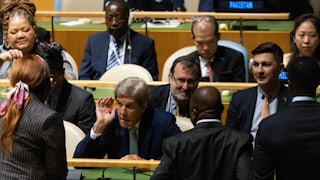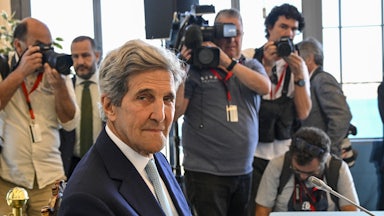On stage at U.N. climate talks in Egypt last week, Joe Biden took a victory lap. His 23-minute speech listed a host of his administration’s accomplishments, from rejoining the Paris Agreement to new pledges on climate finance and the Inflation Reduction Act. “It’s going to shift the paradigm for the United States and the entire world,” he said of the latter. “We’re delivering on our promise of leadership, and more and more of the world is standing with us.”
Behind the scenes, those tracking the COP27 talks see plenty of room for improvement from the world’s largest historical emitter. As negotiators discuss how to pay for the rapidly accruing cost of rising temperatures in developing countries, the United States and other rich nations have dragged their feet. The big question in the coming days is whether parties will actually agree to do something to help poorer countries recover—or merely keep talking about doing something. The dynamics of these negotiations encapsulate why U.N. climate talks can feel like a bureaucratic, impenetrable exercise in rearranging the deck chairs on a sinking ocean liner.
Funding for helping developing countries deal with climate disasters richer nations have caused is colloquially referred to as “loss and damage” financing. Among other matters, a draft negotiating text released Monday laid out what national delegations see as the choices for what to do until 2024, based on last week’s discussions. “Option 1”—loosely representing the position of the G77 plus China negotiating bloc of developing countries—states that there should be an agreement within the next week to form a “new operating entity” for loss and damage financing that will be up and running by November 2024, with the next two years devoted to figuring out the details. Option 2—the stance pushed by several wealthier countries, including the U.S.—is to spend that time on discussions about how it might be possible for the UNFCCC and Paris Agreement to use a “mosaic of funding arrangements,” at some point, to respond to the need for loss and damage financing.
That’s the context in which the G7 countries—headed by Germany—held an official launch event Monday for an initiative known as the Global Shield Against Climate Risks, alongside the 58 countries included in the V20 grouping of climate-vulnerable nations. The push, which got a shout-out from Biden in his speech on Friday, will establish three main financing vehicles to help poorer countries pay for climate damages. The first would involve directing funds from wealthier countries to offset the cost of insurance policies that will kick in when disasters strike. Another vehicle would direct funds toward existing, related programs at multilateral development banks. The third element is a fund to provide grants to projects developed by climate-vulnerable V20 countries and those in the Climate Vulnerable Forum, another Global Shield partner. The first recipients of Global Shield funds will be Bangladesh, Costa Rica, Fiji, Ghana, Pakistan, the Philippines, and Senegal, and several countries have already pledged money toward the initiative.
At best, critics say, Global Shield can play an important but modest role in meeting the massive need for loss and damage financing; it can’t meaningfully address creeping changes like sea level rise and desertification, for instance. It also won’t be accountable to the UNFCCC. At worst, Global Shield is seen as a harmful distraction, deflecting focus away from the need to establish a dedicated body to collect and distribute loss and damage funds and sowing divisions among the G77 and China (the bloc calling for this dedicated loss and damage financing body). “It’s very hard to say insurance is bad,” Adrián Martínez, director of the Costa Rican NGO La Ruta del Clima, told me, referring to the Global Shield’s focus on insurance schemes. He and other civil society observers had just been kicked out of a negotiating room on the issue, pursuant to a rule instituted last year at COP26—meant as a Covid precaution—that no one could watch proceedings if they didn’t have a chair. “The tool itself is not bad; it’s the fact that you’re promoting it as an alternative to what vulnerable countries want at this moment. It’s a tactical move to defeat what those countries actually require.”
European ministers denied that Global Shield was being used to distract from more comprehensive solutions, namely deciding to establish a dedicated new body for loss and damage financing overseen by the U.N. “It is not a kind of tactic to avoid formal negotiation on loss and damage funding arrangements here,” German development minister Svenja Schulze told Reuters on Monday. “Global Shield isn’t the one and only solution for loss and damage. Certainly not. We need a broad range of solutions.”
At a press conference on Saturday, U.S. climate envoy John Kerry offered a subtle nod to the U.S. position, reiterating the U.S. commitment to “find the best ways of harnessing the capacities of existing institutions and fill the gaps in the response thus far” (his emphasis). To read between the lines: The U.S. is not supporting any new bodies to fund loss and damage. When The Guardian’s Fiona Harvey asked him to elaborate, Kerry responded bluntly. “Frankly, I don’t think anyone has fully defined what a ‘facility’ is,” he said, referring to a loss and damage financing facility that has been discussed extensively over the last several years. “We will engage in a very real and genuine dialogue about how do we do this best. It’s complicated.” He reiterated to Lisa Friedman of The New York Times that the U.S. is “not at a facility discussion yet. We’re trying to discuss what financial arrangements might be.”
Unless you’ve spent a great deal of time attempting to understand what’s going on at COP, all of the above will sound perfectly reasonable. There’s a massive need to fund loss and damage. The U.S. has agreed that it is important to have a discussion about how to get those funds to the right places and fill the gap. It even agreed to put loss and damage on the official agenda for this year’s talks, meaning there needs to be some kind of outcome decided by the time negotiators leave Sharm El Sheikh next weekend. It’s supporting an initiative that will help do that. Everyone agrees on the goal, U.S. negotiators say. The debate is about how to get there, and solutions are complicated. Let’s not rush it.
Yet this bears an eerie resemblance to the delay tactics used most infamously by fossil fuel companies to reject the idea that their core business model is the problem. Adamant about their commitment to a low-carbon future, major oil and gas drillers—who have 25 percent more lobbyists at COP27 than attended last year’s talks—have mostly stopped casting doubt on the reality of climate change. After years of pressure and bad P.R., they’ve turned to what William F. Lamb and his co-authors on a 2020 Global Sustainability paper dub “discourses of delay,” deployed by corporations and governments alike. While this paper focuses on emissions mitigation efforts, there are more than a few parallels to how wealthy countries (including the U.S.) are relating to loss and damage. The strategies fossil fuel companies deploy often “contain partial truths and may be put forward in good faith,” Lamb and his co-authors write, but lead to a “sense that there are intractable obstacles to taking action.” One type of delaying tactic is policy perfectionism—the idea that policymakers “should seek only perfectly crafted solutions that are supported by all affected parties; otherwise we will waste limited opportunities for adoption,” as the authors summarize. Another strategy is more pithy: “all talk, little action.”
For many wealthy countries grappling with demands to furnish funds for loss and damage, more talk is the goal—and there is no clear destination in sight as to what they hope to achieve after two more years of dialogue about options on loss and damage financing. “They are not talking about a funding facility. They are talking about committing funding or providing funding or thinking about some mechanism for funding,” says Liane Schlatak, associate director of the Heinrich-Böll-Stiftung’s Washington, D.C., office, who leads its work on climate finance. “I have not heard any of them in their interventions say, ‘Let us just take those two years to figure it out and at the end of it, it is going to be the loss and damage financing facility.’”
After years of discussion, those advocating for concrete commitments on loss and damage are understandably wary of calls for more dialogue—the place where the U.S. landed last year, as well. “It would be really egregious to come out of this COP with just procedural decisions on this,” said Rachel Cleetus, policy director with the climate and energy program at the Union of Concerned Scientists. “We need a clear decision.”
Developing countries aren’t asking for a financing facility (or whatever it might be called) to be up and running this year, or for that eventual body to be the sole means through which loss and damage funds are raised and distributed. They’ve been explicit, as well, that it’s not intended as a means of compensation for historical emissions—fault for historical emissions being one thing the U.S. has always insisted it won’t discuss. The demand is for negotiators to agree simply on the intention of setting up a U.N.-governed fund, like the Green Climate Fund that already finances mitigation projects. For now, though, talk is cheaper.










